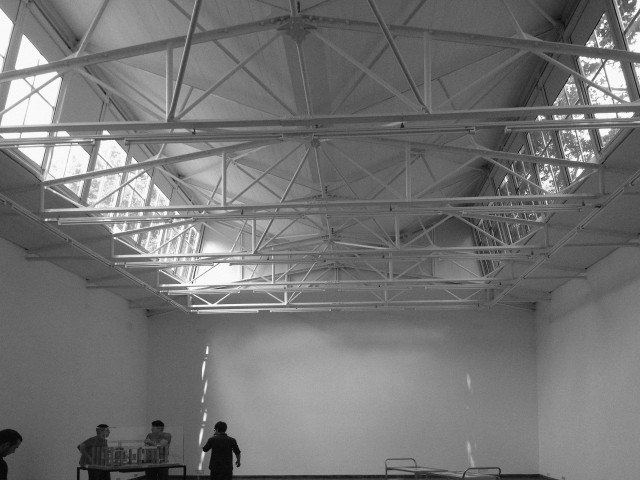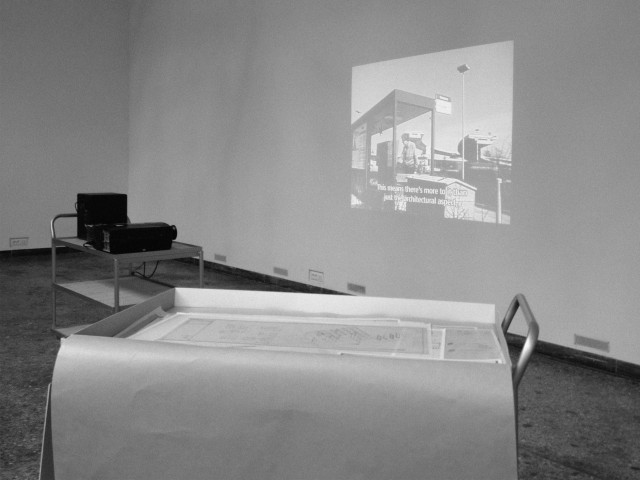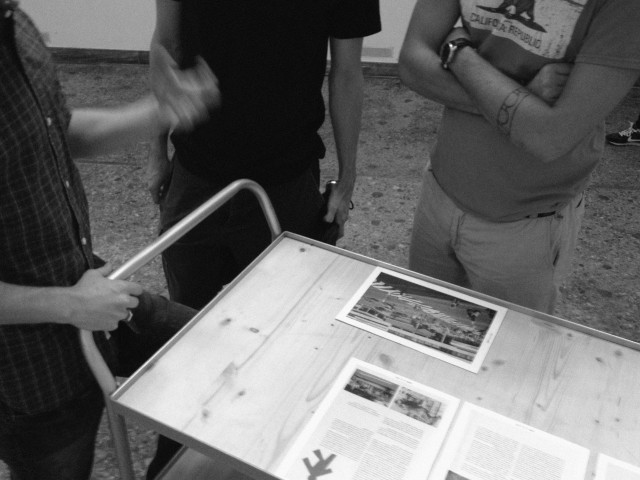


Article by Freek Persyn. Originally published in Accattone issue number 4. Order the full issue here.
When visiting the Swiss Pavilion at the Biennale of Architecture in Venice on 5 June 2014, I found it buzzing like a beehive. I was surprised to encounter so much activity, for I had heard that the core of the current exhibition was an archive – generally not the type of place that generates much energy. However, the exhibition is in fact dedicated to the legacies and archives of two great “serial inventors” – Cedric Price and Lucius Burckhardt – and what it presents takes up their ideas and explores them further.
The core of what is shown are archival documents, which are stored in the central room of the pavilion and brought out in batches on trolleys by a group of assistants (or actors, or performers…) who then unveil (and explain!) what they have brought out for viewing. This procedure feels precious, and it is obviously inspired by the movements and instruments of archivists in order to evoke an experience that combines a sense of grandeur with the immediate and profane. The archival documents are not mystified: they are shared in a dead-pan way, simply made available. The works in the archive are not treated as things to admire or revere, but rather as points of departure (ideas, possibilities, observations…).
Almost as if to prove this point, the rest of the pavilion is filled with nothing but these points of departure. The archive seems to work like a centripetal force, radiating out and influencing every aspect of the exhibition down to the most minute detail. Employing an approach that is fractal rather than additive, the curator broke down the exhibition into its component elements and then asked people to take care of each of these as projects unto themselves. Or to put it another way, the curator made the fragments expand back outward from the pavilion’s core, thereby exponentially multiplying their radiating effect. One person staged the choreography, another filled the ‘goody bags’, someone else arranged the signage, and yet others set up the pavilion roof, organized the summer school, etc. In the process, each of the people involved inevitably takes on a hybrid of various roles: authors, contributors, subcontractors, producers… Together, these participants produce an informal economy through the exchange of values and ideas, thus turning this small exhibition into a big experience.
The exhibition’s key ‘authors’ are listed on the leaflet handed out at the exhibition entrance. Together with Burckhardt and Price themselves, they are 23 in number, but of course, due to the pavilion’s curatorial approach, the list of authors is actually infinite and ever-expanding. Still, it would be interesting to consider adding one more person to the list of key contributors on the leaflet’s back cover – namely Bruno Giacometti, the architect of the Swiss pavilion in which the exhibition takes place. The reason for proposing his addition to the list is not to argue for the architect’s importance; that discussion would be pointless and even counterproductive, since the whole strength of the exhibition lies in the urgent recognition of the need to think beyond and outside of these categories. I think it would be interesting to consider his authorship because of the nature of the work he produced: he designed and built the pavilion in 1951–52 as a simple and humble building made of brick and a bit of concrete, with an entrance that ambiguously opens into a couple of rooms aligned along a patio. Ever since I visited this building for the first time, I have been surprised by its effortless transition from outside to inside, by the way it is at once grand and intimate and by how it manages to embody the tension between these two opposing characteristics.
Today, as it hosts a partial model of the Fun Palace at its core, it shows its true potential to be a Fun Palace in its own right. Now that an artist has made its sunscreens move up and down in a seemingly random sequence, its capacity to generate radically different conditions suddenly emerges forcefully. Now that the chief curator has used its patio as a theatre, the manner in which its walls are capable of creating intimacy and a sense of collective experience becomes strikingly evident. It is as if this Biennale’s exhibition has awakened the pavilion while questioning and implicitly critiquing the Fun Palace in the process. Contrary to Price’s design, Giacometti’s pavilion doesn’t suggest that cultural spaces should function like shipyards or construction sites, places generated by cranes and machines where the maintenance of flexibility requires constant effort. It feels as if, fifty years after their inception, Cedric’s ideas and thoughts have found expression at a size and scale that are closer to those of the human body in a building that is more of a ruin than a machine. The physical changes the pavilion presents are rather limited: one can open a door, close some shutters, move a sliding wall. Flexibility is not a burden, but an offer of possibility. In all its humility, Giacometti’s building generates a varied set of almost dormant conditions that are awakened by the movement of human bodies or the flick of an electrical switch. Surprisingly, its greatest expression of flexibility lies in its spatial ambiguity and the way it confounds categories. The building sets a tone: the movements and interactions it allows combine domesticity with splendor – the person with the trolley is not exiting the kitchen to serve you tea, but rather emerging from the archive in order to share some of the greatest ideas of the 20th century in an intimate way. This ritualistic exhibition-performance feels both familiar and strange, which is another way of saying that it feels new.
Something new is exactly what the curator has offered us: out of the remnants of the recent past – the legacies of Burckhardt, Price and Giacometti – he has forged a temporary alliance interconnecting scientists, artists and architects (among others) and thereby generated something fresh. What is presented and performed in the Swiss pavilion at this year’s Biennale in Venice is a true experiment that even goes so far as to set an agenda: it challenges us to script new experiences for our ever-changing society whose ruins and rituals are in constant need of re-invention.